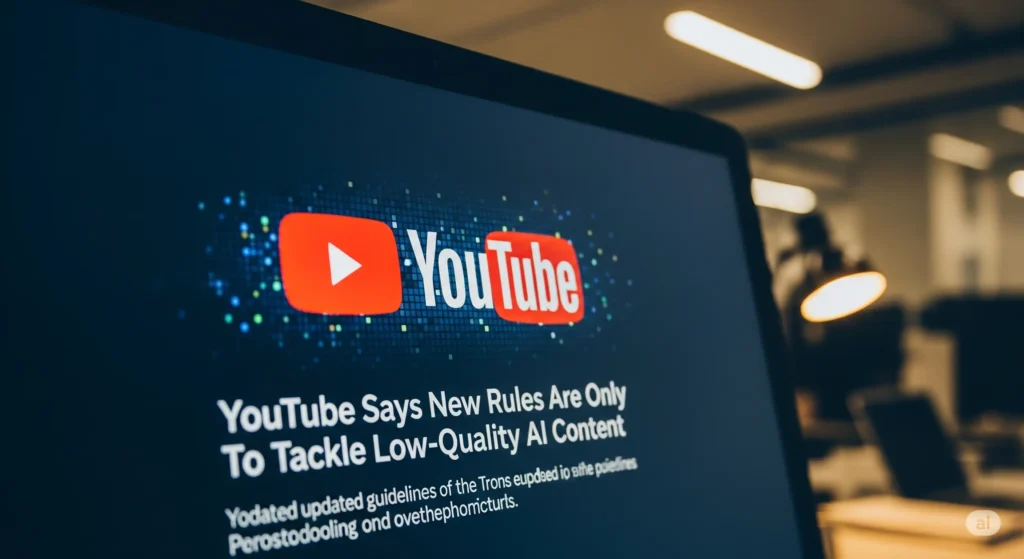
YouTube usually pays $0.003 to $0.005 for each view. You can expect to earn between $3,000 and $5,000 for one million views. But is it as easy as it looks?
Well, there are rules and regulations to follow. It’s like a game you are playing, and you have to keep yourself from getting hit.
And monetization rules are something that keeps changing.
Recently, YouTube has announced its new rules for monetization. If you are someone who relies on AI tools to create your videos or use repeated content, then you have to listen up.
These changes can demonetise your channel or have limited ads.
So, let’s dive deep into the article to keep your channel safe and monetised. Let’s get into it!
YouTube Partner Program (YPP)
YouTube recently announced that from 2021 to 2023, YouTube paid over $70 billion to creators, artists, and media companies, all through YPP.
This program allowed creators to make money from videos by meeting YouTube’s requirements, like 1,000 subscribers and 4,000 watch hours. Here’s what they could do more with this program:
- Ad revenue: You get paid when ads play on your videos. For longer videos, you get 55% of the money. For Shorts, you get 45%.
- Fan support: Fans can pay you through things like channel memberships, Super Chats, and more.
- Shopping: You can sell your own products or recommend other products in your videos.
- YouTube Premium: You also earn money when YouTube Premium members watch your videos.
What’s Happening Now?
To earn money with the YouTube Partner Program (YPP), it was always necessary to make original and real content. But now, they have updated the rules to spot videos that are:
- Copied
- Mass-produced
- Repeated over and over
All these efforts are just being made to spot “fake” or “low-effort” content, it looks like. These changes are also happening because there is so much content made just to get views instead of real, creative work.
Key Points For Updation
YouTube has not shared a full list of what counts as “mass-produced” or “fake.” Here are the main things they are looking at:
- Copied content with little change: Just adding background music, speeding up the video, or cropping it is not enough anymore. You must change the content a lot to make it original.
- Repetitive videos with no real purpose: Videos that look the same over and over, follow the same template, or are made only to get views (especially in Shorts) will face more checks.
- Clickbait and spammy uploads: Channels that trick people or post lots of low-quality videos just to beat the system are being targeted.
YouTube is making these changes to protect the quality of videos on the platform and keep advertisers happy. Brands also want their ads to run next to real, high-quality content, so YouTube wants to be sure ad money goes to creators who actually add value.
YouTube Says New Rules Are Only To Tackle Low-Quality AI Content

On Thursday, YouTube shared a new help document to give more details and answer common questions. They explained that their rules about reused content, like commentary and reaction videos, have not changed.
There are clearer rules about what content can make money, and that will help stop the flood of low-quality, AI-made videos. Because AI tools are easier to use now, it is simple for people to create lots of poor-quality videos quickly.
When someone on X guessed that these changes mean fully AI-made videos can’t earn money anymore, YouTube replied that using AI to improve your videos is still okay, as long as you follow all the other rules.
Hopefully, the new guidelines about “mass-produced or repetitive” content will help clean up some of the spam clogging YouTube.
What About Virtual YouTubers?
Virtual YouTubers (VTubers) are those who use animated characters instead of showing their real faces. They will not be affected that much if they use their own voices and make original videos.
Many VTubers have huge fan bases and make a lot of money. But if someone uses only AI to create everything, they could run into problems with the new rules.
What Creators Should Do
Until YouTube shares more details after July 15, creators should:
- Make unique, personal content
- Avoid posting the same type of videos over and over.
- Be careful when using AI tools.
- Make sure their videos are original or useful
Conclusion
YouTube is tightening its monetisation rules, but if you are the one who is creating original, personal, and valuable content, then you do not have to fear. Just make the videos that have their own ideas and effort. This is not just going to keep your channel safe, but it will also build trust with your audience.
Did you like this blog? If yes, then don’t forget to share it with other creators! Do leave a comment below, and subscribe to stay updated.
FAQs
Q1:Does YouTube ban AI-generated content?
Ans: YouTube has pushed back against fears that it’s cracking down on AI-generated content. The platform says it still welcomes AI tools, so long as creators follow the rules.
Q2: Can repetitive content be monetized on YouTube?
Ans: If you’re making money on YouTube, your content should be original and “authentic.” If you borrow content from someone else, you need to change it significantly to make it your own.
Q3:Can AI voice be monetized on YouTube in 2025?
Ans: YouTube is going to stop monetizing content that lacks real human input, especially videos with AI-generated voices.

